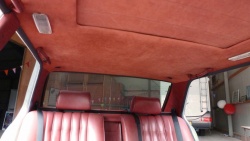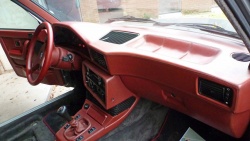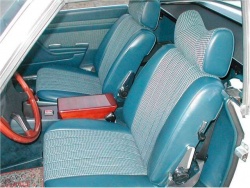Full leather trim
Contents
Full leather trim - Leather appointed - Leather trim
Car manufacturers sometimes sell the interior of a vehicle as a "full leather interior" or "leather appointed" or "leather trim" with corresponding surcharge. In such cases it is assumed, that the entire interior with a grained smooth surface is covered with genuine leather and no artificial leather or plastic parts are processed.
In some countries, the terms "leather trim", "full leather trim" and "partial leather trim" are defined.
According to this, 80% of the expected surfaces of a "leather trim" should be covered with genuine leather.
For a "full leather trim", all surefaces are expected to be real leather. These include the seats (except the back side of the seats), the dashboard, the panels, the center console and also the steering wheel (outer rim only) and the shift knob.
Partial leather trim
The seats in vehicles are not always completely made of leather. Sometimes only the contact surfaces are made of genuine leather, but the side panels, the backs of the backrests and headrests or the armrests are made of imitation leather. Such seats do not have a "leather trim". The only exceptions are the backs of the seats to be a "leather trim".
Partial leather trims are car seats, where some contact areas are made of leather, and the rest is alcantara, artificial leather or fabric. However, it is only "partial leather" if minimum the middle lanes or the outer flanks are made of genuine leather.
Split leather in cars
Auch die Fahrzeughersteller verwenden zunehmend beschichtetes oder geprägtes Spaltleder für die unbelasteten Bereiche (Türverkleidungen, Kopfstützen), aber auch Lenkräder und den Schaltknauf ohne entsprechende Deklaration. Auch das ist in der DIN EN 16223 geregelt. Man muss in diesem Fall davon ausgehen, dass sich die Lederhersteller und die Lederindustrie bei dieser Norm einen Freibrief ausgestellt haben. Vertreter der Konsumenten waren an dieser Normfassung wohl nicht beteiligt. Der Käufer erwirbt dann gutgläubig eine hochwertige "Lederausstattung" oder "Volllederausstattung" und erhält auf Flächen außerhalb des Kontaktbereichs das weniger hochwertige Spaltleder. Da diese beschichtet und geprägt sind, kann selbst ein Fachmann nicht erkennen, ob es ein wertigeres Narbenleder oder ein preiswerteres Spaltleder ist. Daher sollte der Käufer selbst bei den hochpreisigen, nationalen Marken bewusst nachfragen und man sollte sich im Kaufvertrag zusichern lassen, dass kein Spaltleder verbaut wurde, sondern das wertigere "Narbenleder".
Bei Ledermöbeln ist die Regelung erheblich transparenter. In der RAL-GZ 430/4 ist auch geregelt, dass Spaltleder nicht im Kontaktbereich verwendet werden darf, aber es muss trotzdem deutlich darauf hingewiesen werden, dass es zum Einsatz gekommen ist. In diesem Fall ist der Konsument darüber informiert, was er für seine Kaufsumme erworben hat.
BMW E28 M5 von 1986 mit einer Volllederausstattung. Sogar der Himmel ist aus Nubukleder, was selbst bei einer Volllederausstattung nicht erwartet wird.
Klassische Teillederausstattung - Teilleder im Opel Omega
BMW Z1 "fungelb" mit Teilleder
Bild 1: Lancia mit Alcantara-Leder - Bild 2: BMW X3 Teilleder
Kein Teilleder: Mercedes Stoff-Kunstleder - Golf "Aigner" - Nicht genug Leder für "Teillederausstattung"'
BMW Teilleder. Leder außen, innen Stoff mit Lederstreifen verwoben
Additional information




















 a kotori web solution
a kotori web solution